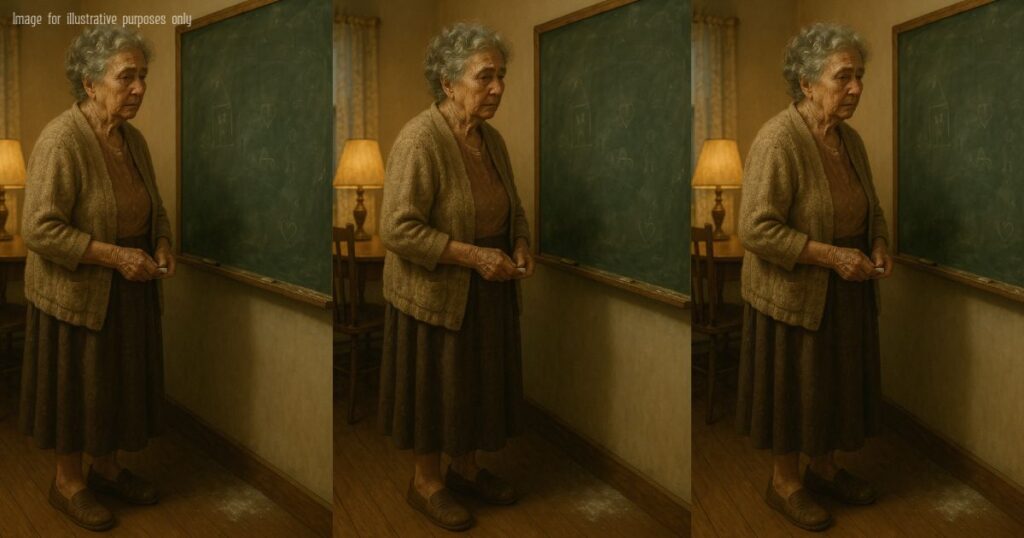“I used to command a room with nothing but a piece of chalk and a raised eyebrow.”
That’s what Margaret told her granddaughter Emma on the first day of tutoring. The words came out with a laugh, but there was something behind them — a weight that didn’t go away, even with all these years and all this quiet.
Margaret Reynolds had taught first grade for thirty-nine years. She retired in 2003 when smartboards started showing up in every classroom and the district told her that her chalkboard was “a safety concern.” They gave her a plaque and a cake shaped like a pencil. Nobody remembered to spell her name right on the frosting.
Now she was 74, and her granddaughter Emma, nearly six, was struggling with numbers. The school said she might not be ready for first grade. Margaret didn’t care much for that assessment. The child was bright — curious as a crow, always asking questions. She just needed someone who understood that math wasn’t a monster but a melody, if taught right.
So Margaret cleaned off her old slate board — the one she’d kept out in the garage, wrapped in a painter’s tarp — and set it up in the dining room. She placed a little wooden stool beside it, low enough for Emma’s short legs to dangle.
“Are we playing school?” Emma asked, eyes wide.
“No, darling,” Margaret said, smiling softly. “We’re going on adventures.”
Every morning, after oatmeal and before her daughter’s Zoom meetings began, Emma would sit on that stool, and Margaret would reach into her desk drawer for her box of chalk — pale white, just like always. No markers, no tablets, no gimmicks.
Just chalk. And a story.
“Today,” Margaret said one Tuesday, “we’re climbing Mount Addition.”
She drew a jagged mountain peak on the board and two stick figures — one for Emma, one for herself — ascending it, one plus one step at a time.
“Why are we climbing?” Emma asked.
“To reach the treasure, of course.”
Each problem was a stepping stone. Each correct answer earned a gold star drawn beside the trail. When Emma struggled, Margaret didn’t sigh or glance at a clock. She simply paused, erased the chalk gently with the edge of her sleeve, and said, “Let’s find another way up.”
It was how she always taught — with patience, with kindness, with grit.
Some days they visited “Subtraction Swamp,” where you had to give things away to the crocodiles. Other times it was “Multiplication Mine,” and they’d dig for matching pairs of gems. To Emma, it was all make-believe. But to Margaret, it was memory. She’d done this dance a thousand times, with a thousand children, in a thousand rooms filled with posters, broken crayons, and the smell of paste.
Only now, the room was still. Just the ticking clock and the occasional creak from the furnace vent. She missed the hum of twenty little voices, the shouts of “Mrs. Reynolds! He took my eraser!” and the quiet magic when a child’s eyes lit up with understanding.
But this — this was enough.
One morning, about two weeks in, Emma asked, “Grandma, why don’t you teach at school anymore?”
Margaret paused, halfway through drawing a marching band of fractions.
“I got older,” she said. “And schools changed.”
Emma looked puzzled. “Changed how?”
“Well,” Margaret said, choosing her words like she chose her chalk — carefully — “they started using computers for everything. And screens. And teachers had less time to really sit with each kid. They wanted speed. I was always more about… planting seeds.”
Emma thought for a moment, then nodded as if that explained everything.
That afternoon, Margaret sat on the porch with her tea and watched Emma draw a hopscotch grid on the sidewalk with leftover chalk. Her little legs jumped from square to square, counting out loud with glee. The sight made Margaret smile — wide and full, the kind of smile that went deep into the soul.
She remembered the old days. Field trips in yellow buses that smelled like peanut butter sandwiches. The feel of little hands in hers as they crossed the street. Snow days. Spelling bees. Retirement had felt like walking off a cliff — one day she was “Mrs. Reynolds, Room 103,” and the next she was just… Margaret. A ghost in sneakers, wandering grocery store aisles with no one to read stories to.
But here, with her granddaughter, she was back. Not for a paycheck. Not for a plaque. But for something better.
One day, Emma brought home a worksheet. “I got all of them right,” she said, beaming.
Margaret looked it over — neat, clean, proud little numbers lined up like soldiers. At the bottom, a gold sticker. She ran her hand across the paper and felt her throat tighten.
“Your teacher must be proud,” she whispered.
Emma shrugged. “She’s nice. But she teaches on a screen.”
Margaret nodded. Of course she does.
That night, Margaret walked into the dining room and stared at the old chalkboard. It was covered in smudges and fingerprints. A trail of white dust lined the edge of the rug. She picked up a piece of chalk — worn down from days of drawing castles, dragons, and math problems disguised as riddles — and held it like she used to.
She thought of all the children she’d taught. The ones who came in shy and left full of confidence. The ones who cried on the first day and hugged her goodbye in June. The ones who never liked math but loved stories. She wondered if they remembered her. If they ever thought of Room 103. If, when they saw chalk dust, they thought of how numbers could be beautiful.
She drew one last heart on the board — just a simple white heart — and stood there a moment longer.
The next day, Emma didn’t need help. She finished her homework on her own and asked if she could read Grandma a story instead.
“Of course,” Margaret said, sitting back in her chair.
Emma opened the book and began, her voice soft but sure. Margaret closed her eyes and listened, each word falling like snow, gentle and warm.
The room was quiet, but full.
And as Emma turned the page, Margaret realized something:
She hadn’t just taught her granddaughter math.
She’d taught her how to believe in the slow magic of showing up, day after day.
How to be gentle with mistakes.
How to hold space for wonder.
And in doing so, she’d left behind the only legacy that mattered — not in a plaque or a pension check, but in a child’s voice, steady and strong, reading stories in the same room where she once learned to count.
Sometimes, the chalk may fade — but the lessons don’t.
Margaret knew something was wrong the second Emma came in with her head down and her backpack slung low like a burden too heavy for a six-year-old.
“Grandma,” she whispered, dropping her bag on the floor. “Can we skip today’s adventure?”
Margaret, who had already drawn a winding number maze on the board and laid out a plastic crown for their usual “Princess of Patterns” game, paused.
She studied her granddaughter’s face — red around the eyes, lips pulled tight the way children do when they’re holding in something big.
“What happened, sweetheart?”
Emma didn’t answer at first. Just walked over to the chalkboard and erased the maze in one long, angry swipe of her hand.
“I don’t want to do math anymore,” she said. “It’s dumb.”
That hit Margaret harder than she expected. Not the insult to arithmetic, but the defeat in the girl’s voice — like a door quietly clicking shut on something they’d built together.
Margaret knelt, her knees creaking louder than the floorboards, and looked Emma straight in the eyes.
“What happened?”
Emma hesitated. “Mrs. Keene says I don’t show my work right. She marked them wrong… even though they were right.”
Margaret’s stomach dropped. She’d seen this before — not from malice, but from systems that wanted neat columns and cookie-cutter children.
“She said I don’t think the ‘normal’ way.”
At that, Margaret stood up. Slowly. Stiffly. She didn’t say a word. Just turned and walked into the hallway. Emma, startled, watched her go.
That was the moment to break the story — a sharp emotional turn that leaves the reader needing to know what Margaret will do next.


